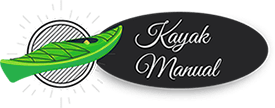The use of a rudder on a kayak vastly improves its navigational abilities, providing enhanced control, especially in changing water conditions. However, not all kayak models come equipped with a rudder. Does this mean you should settle for lesser control? Absolutely not. With a little creativity and some elbow grease, it’s entirely possible to retrofit a rudder to your kayak. If your kayak does not have a factory rudder option but with some ingenuity it can be installed.
01. Mounting the Rudder
On top, I used the existing screws used for the handle. On the bottom I drilled one hole and used a wellnut. This process capitalizes on pre-existing features of the kayak and adds just one additional element, the wellnut, which provides a secure fastening point for the rudder system.
02. Rudder retractor/ cables entering the hull
This whole kit is a Wilderness systems setup. I drilled 2 new holes in tighter to the center to shorten the needed cable pull distance. Reducing cable pull distance enhances the response of the rudder, thereby improving the overall handling of the kayak.
03. Running the Cables in the Rear
Drilled on an angle, then I cut the nylon cable sheathing on an angle and melted and pressed the end forming a lip so it wouldn’t slip back into the hull. This technique ensures that the cable sheathing remains secure and doesn’t slip into the hull, ensuring uninterrupted function of the rudder system.
04. Rudder Retractor Side View
Again, the retractor parts were in the kit. It did have to be shortened though. By adjusting the retractor to suit the kayak’s specific dimensions, we ensure that the rudder can be lifted and lowered with ease, thereby improving the overall efficiency and versatility of the kayak.
05. Toe Pilot Setup
These are the ones that Cobra uses. It’s plastic, except for the hinges. KFS makes a real nice stainless set also. These feel a little too flexible. Soon I’ll make my own. Probably out of Aluminum. The choice of materials for the toe pilot setup can greatly influence the durability and responsiveness of your rudder system.
06. Toe Pilot Setup 2
Here is another view of the Toe Pilot setup. Note the small pieces of bungee on the outside of each pedal to keep them from falling back. This little addition of bungee cords ensures that the pedals stay in position, providing the necessary resistance when operating the rudder.
06. Front Cable Run
Same as the rear. Drilled on an angle, cut the sheathing on an angle, melted it to create a lip and it won’t slip back in. The technique keeps the sheathing secure and protects the rudder cables, extending the life of the rudder system.
07. Rudder Seat
This part also came with the kit. Although one could easily be fabricated. This component allows the rudder to rest when not in use, preventing unnecessary wear and tear.
Conclusion
In conclusion, retrofitting a rudder on a kayak that didn’t come with one isn’t as daunting as it might initially appear. With some strategic planning, the right tools, and a step-by-step approach, you can greatly enhance your kayak’s maneuverability and your overall paddling experience. Remember, every kayak is unique and might require certain adjustments to these steps, but with a touch of ingenuity, the reward is a more navigable and enjoyable kayak experience.
